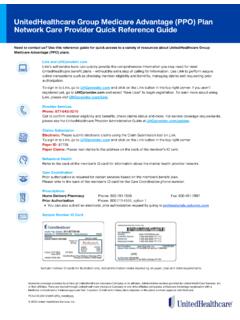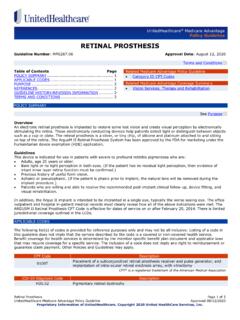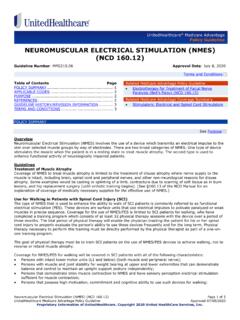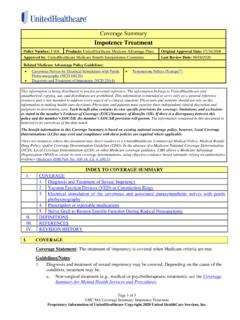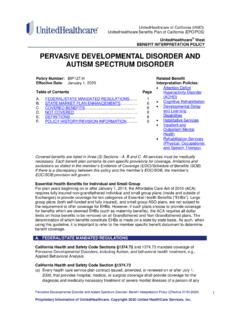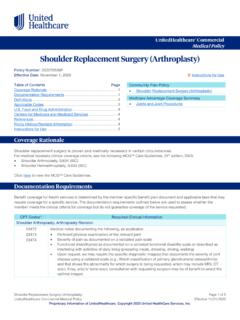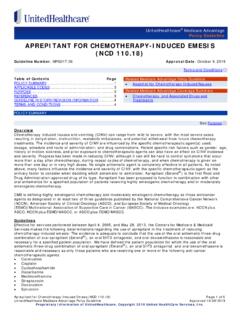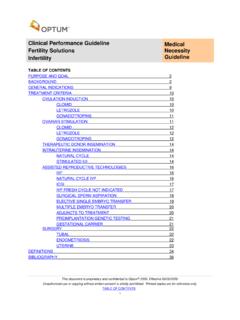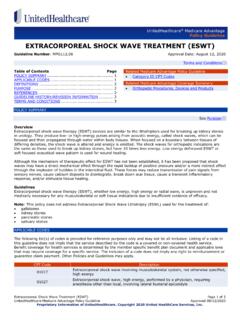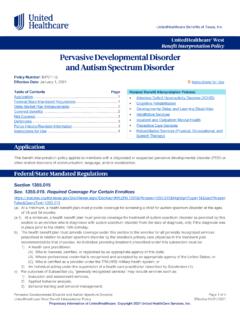Transcription of Coverage Rationale Applicable Codes - UHCprovider.com
1 Prolotherapy and Platelet Rich Plasma Therapies Page 1 of 24 unitedhealthcare Commercial Medical Policy Effective 01/01/2022 Proprietary Information of unitedhealthcare . Copyright 2022 United HealthCare Services, Inc. unitedhealthcare Commercial Medica l Policy Prolotherapy and Platelet Rich Plasma Therapies Policy Number: 2022T0498V Effective Date: January 1, 2022 Instructions for Use Table of Contents Page Coverage Rationale .. 1 Applicable Codes .. 1 Description of Services .. 2 Clinical Evidence .. 2 Food and Drug Administration .. 18 References .. 18 Policy History/Revision Information .. 23 Instructions for Use .. 23 Coverage Rationale Due to insufficient evidence of efficacy, the following are unproven and not medically necessary for any condition or indication: Prolotherapy Platelet-Rich Plasma Note: Refer to the Medical Policy titled Skin and Soft Tissue Substitutes for information related to amnion-derived fluid injections/therapy.
2 Applicable Codes The following list(s) of procedure and/or diagnosis Codes is provided for reference purposes only and may not be all inclusive. Listing of a code in this policy does not imply that the service described by the code is a covered or non-covered health service. Benefit Coverage for health services is determined by the member specific benefit plan document and Applicable laws that may require Coverage for a specific service. The inclusion of a code does not imply any right to reimbursement or guarantee claim payment. Other Policies and Guidelines may apply. CPT Code Description 0232T Injection(s), platelet rich plasma, any site, including image guidance, harvesting and preparation when performed CPT is a registered trademark of the American Medical Association HCPCS Code Description G0460 Autologous platelet rich plasma for nondiabetic chronic wounds/ulcers, including phlebotomy, centrifugation, and all other preparatory procedures, administration and dressings, per treatment G0465 Autologous platelet rich plasma (PRP) for diabetic chronic wounds/ulcers, using an FDA-cleared device (includes administration, dressings, phlebotomy, centrifugation, and all other preparatory procedures, per treatment)
3 M0076 Prolotherapy Related Commercial Policy Skin and Soft Tissue Substitutes Community Plan Policy Prolotherapy and Platelet Rich Plasma Therapies medicare Advantage Coverage Summary Wound Treatments Prolotherapy and Platelet Rich Plasma Therapies Page 2 of 24 unitedhealthcare Commercial Medical Policy Effective 01/01/2022 Proprietary Information of unitedhealthcare . Copyright 2022 United HealthCare Services, Inc. HCPCS Code Description P9020 Platelet-rich plasma, each unit Description of Services Prolotherapy (Proliferative Therapy), also known as Non-Surgical and Ligament and Tendon Reconstruction and Regenerative Joint Injection, is an orthopedic procedure that stimulates the body s healing processes to strengthen and repair injured and painful joints and connective tissue. Prolotherapy is injection of any substance ( , dextrose, saline, sarapin and procaine or lidocaine) that promotes growth of normal cells, tissues, or organs by stimulating the body s natural healing mechanisms to lay down new tissue in the weakened area.
4 This is done by a very directed injection to the injury site, tricking the body to repair again. The mild inflammatory response which is created by the injection encourages growth of new, normal ligament or tendon fibers, resulting in a tightening of the weakened structure. Additional treatments repeat this process, allowing a gradual buildup of tissue to restore the original strength to the area. In the last several years newer formulas include Platelet Rich Plasma (PRP) and autologous (from the same person) adult stem cell sources, typically taken from bone marrow or adipose (fat) tissue. Each treating physician tailors the selection of the appropriate formula according to the patient s need. The three types of prolotherapy are: 1) Growth factor injection prolotherapy; 2) Growth factor stimulation prolotherapy; and 3) Inflammatory prolotherapy (AOAPRM, 2020; AAOM, 2020).
5 Platelet rich plasma (PRP) is an autologous blood preparation with a high platelet concentration and concentrated platelet-derived growth factors and other cytokines, which may be the primary contributors to the benefits of PRP therapy. Introducing PRP to tissues with low healing potential, these growth factors and cytokines may stimulate regeneration and promote tissue repair. PRP preparations are not standardized and exhibit wide variability in platelet and white blood cell concentrations. It is unclear how these variations in PRP composition may affect clinical outcomes (Hayes, 2021). Clinical Evidence Prolotherapy The available studies on prolotherapy are limited to those that include short to medium term follow-up with no significant functional improvement compared to placebo. Additional studies are needed to further define treatment parameters and to determine whether a clinically significant improvement is achieved.
6 Low Back Pain (LBP) A systematic review by Chou et al. (2009) included 174 articles of which 97 met criteria to assess the benefits and harms of nonsurgical interventional therapies for low back and radicular pain. Of the 97, only 5 addressed prolotherapy. Three of these studies found no difference between prolotherapy and either saline or local anesthetic control injections for short- or long-term (up to 24 months) pain or disability. One higher quality trial found prolotherapy associated with increased likelihood of short-term improvement in pain or disability versus control injection, but both treatment groups received a number of co-interventions including spinal manipulation, local injections, exercises, and walking. In the fifth trial, effects of prolotherapy could not be determined because the prolotherapy group received strong manipulation and the control injection group only light manipulation.
7 The authors concluded that prolotherapy has not been found to be effective for the treatment of low back and radicular pain. A systematic review by Dagenais et al. (2008) of articles on prolotherapy published from 1997 to 2007 concluded that that prolotherapy is one of a number of treatments recommended for CLBP. Prolotherapy has a long history of use, a reasonable but not proven theoretical basis, a low complication rate, and conflicting evidence of efficacy. It is considered contraindicated in patients with metastatic cancer, non-musculoskeletal pain, spinal anatomical defects, systemic inflammation, morbid obesity, bleeding disorders, low pain threshold, inability to perform post treatment exercises, chemical dependency, or whole-body pain. Because high doses of a prolotherapy solution containing dextrose , glycerin , phenol , and lidocaine may produce a temporary increase in hepatic enzymes, it may not be prudent to not administer these solutions to patients with pre-existing hepatic conditions.
8 In a 2007 Cochrane Review on prolotherapy injections for CLBP, Dagenais et al. concluded that there is conflicting evidence regarding the efficacy of prolotherapy injections for patients with CLBP. When used alone, prolotherapy is not an effective Prolotherapy and Platelet Rich Plasma Therapies Page 3 of 24 unitedhealthcare Commercial Medical Policy Effective 01/01/2022 Proprietary Information of unitedhealthcare . Copyright 2022 United HealthCare Services, Inc. treatment for this condition. When combined with spinal manipulation, exercise, and other co-interventions, prolotherapy may improve CLBP and disability. Conclusions are confounded by clinical heterogeneity amongst studies and by the presence of co-interventions. Osteoarthritis (OA) Gul et al. (2020) performed a randomized controlled trial (RCT) to determine the efficacy of prolotherapy injections versus exercise in the treatment of osteoarthritis secondary to developmental dysplasia of the hip.
9 The study consisted of 41 patients divided into two groups: treated with prolotherapy (n=20) and exercise (control group; n=21). Clinical outcomes were evaluated at baseline, 3 weeks, 3 months, 6 months, and a minimum of 1 year follow-up. Prolotherapy injection recipients outperformed exercise controls for Visual Analog Scale (VAS) pain change score at 6 months ( versus ; P= ), and 12 months ( versus ; P= ) and for HHS at 6 months ( versus ; P= ) and 12 months ( versus ; P= ). The authors concluded that prolotherapy is superior to exercise and may delay surgery. Limitations include a small sample size which makes it difficult to decide whether these conclusions can be generalized to a larger population. Well designed, comparative studies with larger patient populations are needed to further describe safety and clinical outcomes.
10 Further investigation is needed before clinical usefulness of this procedure is proven. Sit et al. (2020) performed a single-center, parallel-group, blinded, randomized controlled trial (RCT) comparing the efficacy of intra-articular hypertonic dextrose prolotherapy versus normal saline injection for knee osteoarthritis (OA). A total of 76 patients were enrolled in the study and randomized into two groups of 38 each (prolotherapy: n=38; normal saline: n=38) over a 52-week period. Improvement in the DPT group compared with NS group on the primary outcome of WOMAC pain score at 52 weeks was noted. Beneficial effects were also demonstrated in WOMAC function, WOMAC composite, VAS pain intensity, and EuroQol-5D VAS and index scores. The composite WOMAC score improvement in the DPT group exceeded the minimal clinical important difference of 12 points at 52 weeks.
